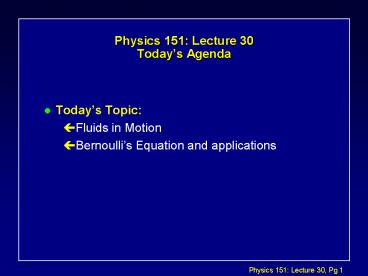Physics 151: Lecture 30 Today - PowerPoint PPT Presentation
1 / 15
Title:
Physics 151: Lecture 30 Today
Description:
A beaker of mass mbeaker containing oil of mass moil (density = roil) rests on a ... ( Assume that the air is stagnant at point A and take rair = 1.25 kg/m3. ... – PowerPoint PPT presentation
Number of Views:91
Avg rating:3.0/5.0
Title: Physics 151: Lecture 30 Today
1
Physics 151 Lecture 30 Todays Agenda
- Todays Topic
- Fluids in Motion
- Bernoullis Equation and applications
2
Example / Fluid Statics
- A beaker of mass mbeaker containing oil of mass
moil (density roil) rests on a scale. A block
of iron of mass miron is suspended from a spring
scale and completely submerged in the oil as in
Figure on the right. - Determine the equilibrium readings of both scales.
3
Fluids in Motion
See text 14.5
- Up to now we have described fluids in terms of
their static properties - density r
- pressure p
- To describe fluid motion, we need something that
can describe flow - velocity v
- There are different kinds of fluid flow of
varying complexity - non-steady / steady
- compressible / incompressible
- rotational / irrotational
- viscous / ideal
4
Ideal Fluids
See text 14.5
- Fluid dynamics is very complicated in general
(turbulence, vortices, etc.) - Consider the simplest case first the Ideal Fluid
- no viscosity - no flow resistance (no internal
friction) - incompressible - density constant in space and
time
5
Ideal Fluids
See text 14.6
- streamlines do not meet or cross
- velocity vector is tangent to streamline
- volume of fluid follows a tube of flow bounded by
streamlines
streamline
- Flow obeys continuity equation
- volume flow rate Q Av is constant
along flow tube.
A1v1 A2v2
- follows from mass conservation if flow is
incompressible.
6
Conservation of Energy for Ideal Fluid
See text 14.7
- Recall the standard work-energy relation
- Apply the principle to a section of flowing fluid
with volume dV and mass dm r dV (here W is work
done on fluid)
7
Lecture 30 Act 1Continuity
- A housing contractor saves some money by reducing
the size of a pipe from 1 diameter to 1/2
diameter at some point in your house.
v1
v1/2
1) Assuming the water moving in the pipe is an
ideal fluid, relative to its speed in the 1
diameter pipe, how fast is the water going in the
1/2 pipe?
8
Lecture 30 Act 2Bernoullis Principle
- A housing contractor saves some money by reducing
the size of a pipe from 1 diameter to 1/2
diameter at some point in your house.
v1
v1/2
2) What is the pressure in the 1/2 pipe relative
to the 1 pipe?
9
DEMO SLIDE
- The smaller the diameter the lower is the pressure
10
Example
- A Pitot tube (see Fig. below) can be used to
determine the velocity of air flow by measuring
the difference between the total pressure and the
static pressure. If the fluid in the tube is
mercury, density rHg 13 600 kg/m3, and h 5.00
cm, find the speed of air flow. (Assume that the
air is stagnant at point A and take rair 1.25
kg/m3.)
11
Venturi Meter
v ? Can we know what is v from what we can
measure ? h rHg rair
12
Example
- A tank containing a liquid of density r has a
hole in its side at a distance h below the
surface of the liquid. The hole is open to the
atmosphere and its diameter is much smaller than
the diameter of the tank. - What is the speed with of the liquid as it leaves
the tank.
h
r
v?
13
Example
- Figure on the right shows a stream of water in
steady flow from a kitchen faucet. At the faucet
the diameter of the stream is 0.960 cm. The
stream fills a 125-cm3 container in 16.3 s. Find
the diameter of the stream 13.0 cm below the
opening of the faucet.
14
Example
- Water is forced out of a fire extinguisher by air
pressure, as shown in Figure below. How much
gauge air pressure in the tank (above
atmospheric) is required for the water jet to
have a speed of 30.0 m/s when the water level in
the tank is 0.500 m below the nozzle?
15
Recap of todays lecture
- 14.4-7
- Streamlines
- Bernoullis Equation and applications































